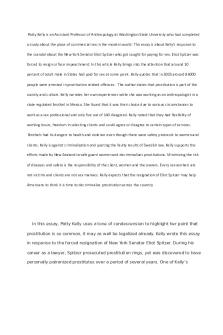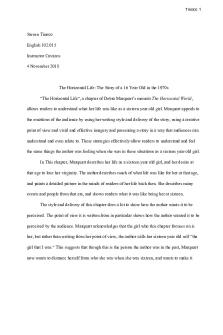Rhetorical Analysis - enc2135 PDF

| Title | Rhetorical Analysis - enc2135 |
|---|---|
| Course | English Composition |
| Institution | Florida State University |
| Pages | 6 |
| File Size | 98.6 KB |
| File Type | |
| Total Downloads | 72 |
| Total Views | 155 |
Summary
enc2135...
Description
Rhetorical Analysis The two artifacts I’ve decided to use are a song by J. Cole and a documentary about homelessness in America. Being that my major is social entrepreneurship, I chose artifacts that address social issues in two completely different ways. The J. Cole song that I chose in called “4 Your Eyez Only”. The song discusses many social problems that exist in America today, a lot dealing with economic inequality, a topic that I am extremely passionate about. A few of the other issues that Cole brings up in the song, are gang violence, issues with the jail system, racial profiling and inequality, differences in socioeconomic status, theft, drug addiction, gun violence, flaws of the education systems, and mass incarceration. This song, in addition to many others by J. Cole, is what originally inspired me to become interested these social problems. With that, my interest in trying to solve these problems led me to choose as social entrepreneurship as my major. The other artifact that I am using is a documentary that I have seen before that is about the homelessness crisis in America. Economic inequality and homelessness are big social problems that have potential to be improved by social entrepreneurship. I am including this documentary in my paper because watching it for the first time changed my perspective about this real problem that exists and the severity of it. Both artifacts highlight social problems in society and use different appeal strategies. The rhetorical appeal used in the song “4 Your Eyez Only” is mostly in the form of pathos. Pathos is used in the way that the song is appealing to the listener’s emotions. The rhythm and beat of the song by them self have an impact on the audience’s emotions. When you then, listen to the actual words, emotions are stimulated even more so. The song is written as a
message from a friend of Cole’s, to their daughter. This puts things into a different perspective meant connect to the audience and evoke feelings of empathy. Cole is telling the story of his friend who explains that he believes he won’t live to see the next day because of the hardships he is going through. “I got a feeling I won’t see tomorrow”. He wants Cole to relay his message to his daughter incase he doesn't survive in the harsh society. He describes the difficulties of surviving in this world with a record “I try to find employment even if it's wiping toilets, But these felonies be making life the hardest” as well as other obstacles he must face. He is doubtful of his chances to survive these conditions and is just about ready to give up, “If the pressure get[s] too much for me to take and I break, Play this tape for my daughter and let her know my life is on it”. The song is very somber and makes the listeners reflect on the real issues that exist in society. The intended audience of his songs is his fanbase and the future generation of people from all socioeconomic statuses. In “4 Your Eyes Only” he explains that he is trying to reach the people affected by these social issues.“I dedicate these words to you and all the other children, Affected by the mass incarceration in this nation”. His goal, like the goal of social entrepreneurship, is to identify the social problems that exist and come up with solutions. Because J. Cole is a celebrity that many people look up to, this song also appeals to ethos. “The listeners need to believe in the authority of the speaker before they will be persuaded by his arguments and emotional messages” (Tarling, 2005). He is sharing a true story “This perspective is a real one”, which is meant to establish his credibility on the subject matter. Music is such a powerful way of conveying a message to the people of today generation. Judy Tarling refers to music as a “weapon of rhetoric” (Tarling, 2005). ”Music has cultural and political contexts and has the power to effect positive change in society (McCarthy, 2013). J. Cole, being the well
known rapper that he is, is using his music and platform to raise awareness and promote social change as a part of the new hip hop movement to inspire his fans to do the same. The other artifact that I’m using, “Homeless in America - Poverty Documentary”, addresses a social problem in a slightly different way. The video focuses on one specific issue, homelessness, and includes personal accounts from people directly affected by poverty. The documentary appeals to logos being that its main purpose is to be informative. The video serves to inform the viewers about the homeless population that exists in the United States as well as give insight about what it is really like to be in their position, so pathos is also a big part of its appeal. In the video, specific stories about different individuals who are struggling and who are homeless are presented. This is meant to show the viewers real life examples of the issue as well as persuade you to feel for and understand the individuals that are being interviewed. A big part of the video is invalidating the stigma surrounding the homeless population. This view is supported by John Blecher in an article about the limits of social change. He explains the irony in the fact that “The public views homelessness as an undesirable social problem and wants it addressed, while at the same time they hold negative views toward people who are homeless and stigmatize them” (Blecher, 2012). The documentary continues to argue that homeless people aren’t as far apart from us as you may think. One man expresses that“Homeless people are good people, they’re just people who are down on their luck”, “all people are one paycheck away from being homeless” (Wiseau, 2004). These statements really put their situation into perspective and make you think differently. Ethos is also used in that experts speak on the issue but also in that these people are experiencing the homelessness so they, in a way, are experts on the issue. The
interviews are meant to establish the credibility of the given information and the problem at hand.
Similarities
Differences
● Both the song and the documentary
● In the song, the structure is in verses as
use a majority of pathos as their
opposed to in the video, where the
rhetorical appeal. They both utilize
information is given in an interview
personal stories to try and connect and
style where questions are asked and
relate to the audience.
answers are given.
● Both discuss issues that exist in society and advocate for social change.
● The song given information in a very inform way. The language is explicit at times and uses a lot of slang terminology whereas the documentary is very professional and formal. ● The song has a generally younger audience than the documentary. ● The song is more figurative and poetic about delivering the message while the documentary is very literal and direct.
After analyzing both artifacts, it is evident that a similar message can be conveyed in so many different ways to be relayed to so many different audiences. I think both the song and the
documentary are effective in persuading each audience of their position. “4 Your Eyez Only” is an inspirational song written by an artist hoping to move his audience toward making a change. “Homelessness in America” is a documentary dedicated to putting you in the shoes of those affected, in hopes to change your perspective and convince you that there is a problem that needs to be solved. Social entrepreneurship is just taking that next step and making these changes really happen.
Works Cited Belcher, John R., and Bruce R. Deforge. "Social Stigma and Homelessness: The Limits of Social Change." Journal of Human Behavior in the Social Environment, vol. 22, no. 8, 2012, pp. 929-946, http://search.ebscohost.com/login.aspx? direct=true&db=a9h&AN=83182582&site=ehost-live, doi: 10.1080/10911359.2012.707941. McCarthy, Marie. "The Young Musicians of Motown: A Success Story of Urban Music Education." Music Educators Journal, vol. 99, no. 3, 2013, pp. 35-42, http:// search.ebscohost.com/login.aspx?direct=true&db=a9h&AN=85920168&site=ehost-live, doi:10.1177/0027432112467647. Tarling, Judy. "'What Passion Cannot Music Raise and Quell?': Emotional Persuasion in Musical Performance using Rhetorical Techniques from Cicero and Quintilian." Early Music Performer, no. 15, 2005, pp. 39-44, http://search.ebscohost.com/login.aspx? direct=true&db=a9h&AN=25190304&site=ehost-live.
"Homelessness in America - Poverty Documentary." , directed by Tommy Wiseau. , 2004....
Similar Free PDFs

Rhetorical Analysis - enc2135
- 6 Pages

Rhetorical Analysis
- 5 Pages

Rhetorical analysis
- 2 Pages

Puppy Rhetorical Analysis
- 4 Pages

Rhetorical analysis -1
- 4 Pages

Bowling Dana Rhetorical Analysis
- 4 Pages

Rhetorical Analysis Essay
- 5 Pages

Textual Rhetorical Analysis
- 3 Pages

Rhetorical Analysis Final
- 5 Pages

Rhetorical Analysis Prompt
- 2 Pages

Final Rhetorical Analysis Essay
- 2 Pages

Rhetorical analysis pt1
- 2 Pages

Rhetorical Analysis Essay
- 4 Pages
Popular Institutions
- Tinajero National High School - Annex
- Politeknik Caltex Riau
- Yokohama City University
- SGT University
- University of Al-Qadisiyah
- Divine Word College of Vigan
- Techniek College Rotterdam
- Universidade de Santiago
- Universiti Teknologi MARA Cawangan Johor Kampus Pasir Gudang
- Poltekkes Kemenkes Yogyakarta
- Baguio City National High School
- Colegio san marcos
- preparatoria uno
- Centro de Bachillerato Tecnológico Industrial y de Servicios No. 107
- Dalian Maritime University
- Quang Trung Secondary School
- Colegio Tecnológico en Informática
- Corporación Regional de Educación Superior
- Grupo CEDVA
- Dar Al Uloom University
- Centro de Estudios Preuniversitarios de la Universidad Nacional de Ingeniería
- 上智大学
- Aakash International School, Nuna Majara
- San Felipe Neri Catholic School
- Kang Chiao International School - New Taipei City
- Misamis Occidental National High School
- Institución Educativa Escuela Normal Juan Ladrilleros
- Kolehiyo ng Pantukan
- Batanes State College
- Instituto Continental
- Sekolah Menengah Kejuruan Kesehatan Kaltara (Tarakan)
- Colegio de La Inmaculada Concepcion - Cebu


